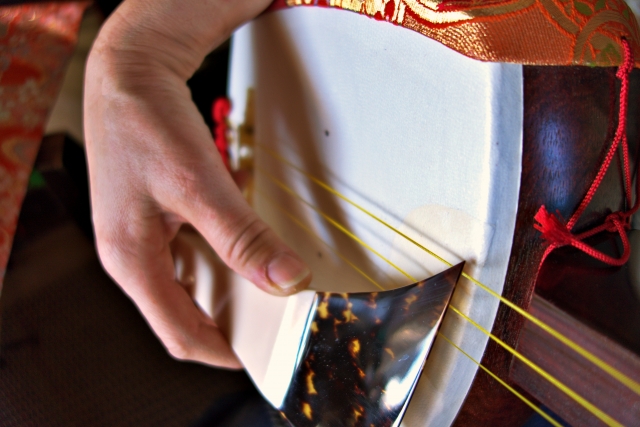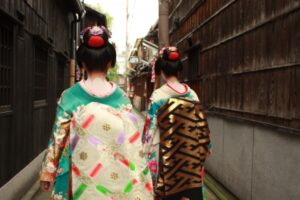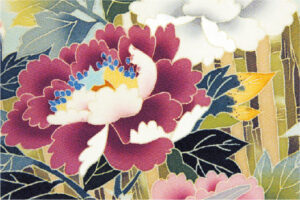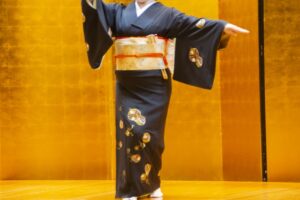日本の祭りや舞台、あるいは静かな座敷で、時に心躍るように、時に物悲しく胸に迫る独特の音色を奏でる「三味線」。そのシンプルな見た目からは想像もつかないほど、多彩な表情を持つこの楽器の真の魅力をご存知でしょうか。三味線は単なる伝統楽器ではありません。それは、時代と共に様々な音楽ジャンルを生み出し、今なお進化を続ける、日本の心を映し出す魂の楽器なのです。
- 琉球から本土へ:三線(さんしん)から三味線への進化の物語
- 棹(さお)の太さが音色を変える:三味線の三大種類とそれぞれの音楽
- 伝統から革新へ:世界が注目する現代三味線の新たな波
三本の弦が紡ぎ出す、日本のソウルミュージック
三味線は、わずか三本の弦と、しなやかな棹、そして動物の皮を張った四角い胴から成り立っています。しかし、そのミニマルな構造から生まれる音は驚くほど豊かです。撥(ばち)が皮を打つ鋭いアタック音、弦が指で押さえられ生み出される繊細な音色、そして何もない空間で響く独特の「間」。これらが一体となり、賑やかな祭り囃子から、人生の機微を語る浄瑠璃の伴奏、魂を揺さぶる津軽三味線の独奏まで、日本文化のあらゆる場面を彩ってきました。この楽器の旅路は、遠く南の島から始まりました。
海を渡ってきた楽器のルーツ
三味線の直接の祖先は、14世紀頃に中国から琉球王国(現在の沖縄県)へ伝わった「三弦(サンシェン)」という楽器だと考えられています。琉球で独自の発展を遂げたこの楽器は「三線(さんしん)」と呼ばれ、今も沖縄の音楽に欠かせない存在です。蛇の皮を張った胴と、指で弦を弾く優しい音色が特徴の三線は、16世紀頃に大阪の堺を通じて日本本土へ伝わりました。本土に渡った三線は、日本の風土や美意識に合わせて大きな変化を遂げます。胴には猫や犬の皮が張られ、弦を「撥(ばち)」と呼ばれる大きなイチョウ型の道具で叩くように弾く奏法が生まれました。こうして、より大きく、鋭い音色を持つ「三味線」が誕生したのです。
音楽ジャンルで姿を変える三味線の世界
三味線の最も興味深い特徴の一つは、演奏される音楽ジャンルによって、楽器そのものの仕様、特に「棹(さお)」の太さが異なる点です。この違いが、それぞれの音楽に最適な音色と表現力を生み出します。例えば、歌舞伎の伴奏音楽である「長唄(ながうた)」では、繊細で軽やかな音色が求められるため「細棹(ほそざお)」が用いられます。一方、人形浄瑠璃「文楽」で物語に力強い情景描写を加える「義太夫節(ぎだゆうぶし)」や、即興的で打楽的な奏法が特徴の「津軽三味線」では、重厚で迫力のある音を出す「太棹(ふとざお)」が使われます。このように、三味線は一つの楽器でありながら、その姿を柔軟に変え、多様な日本の芸能文化を支えてきたのです。
今に生きる三味線の可能性
三味線は、古典芸能の世界に留まることなく、現代においても新たな可能性を広げ続けています。伝統的な奏法を守り伝える継承者がいる一方で、ロックやジャズ、ポップスといった異ジャンルのミュージシャンと積極的に共演し、新たな音楽を創造する奏者も少なくありません。そのダイナミックかつ繊細な音色は、国境を越えて多くの人々を魅了し、海外公演も頻繁に行われています。また、映画音楽やゲーム、アニメーションのBGMとしてもその独特の響きが活用されるなど、三味線は伝統という枠組みを飛び出し、現代文化の中で確かに息づいているのです。

解説ポイント①:琉球から本土へ:三線(さんしん)から三味線への進化の物語
三味線の誕生は、文化の伝播と変容の物語そのものです。その変化のポイントは、素材と奏法に集約されます。
- 起源:中国の「三弦(サンシェン)」 14世紀頃に中国から琉球へ伝わった楽器。これが全ての始まりです。
- 琉球での進化:「三線(さんしん)」の誕生
- 胴の素材: 琉球では、胴にニシキヘビの皮を使用するようになりました。これが三線独特の、柔らかく温かみのある音色を生み出します。
- 奏法: 指や、水牛の角などで作られた小さな爪(チミ)で弦を弾きます。これにより、優しく爪弾くような音になります。
- 本土での変革:「三味線」への変化
- 胴の素材: 日本本土では、蛇皮の代わりに猫や犬の皮が用いられました。これにより、より張りのある、鋭い響きが生まれます。
- 奏法: 指ではなく、イチョウの葉の形をした大きな「撥(ばち)」で弦を叩きつけるように弾く奏法が確立されました。これが三味線特有の打楽器的でアタックの強い音の源です。
- 構造:「さわり」の機構 第一弦(最も細い弦)が棹の一部にわずかに触れることで、「ビーン」という独特の倍音やノイズを生み出す「さわり」という機構が考案されました。これが三味線の音色に深みと複雑さを与えています。
解説ポイント②:棹(さお)の太さが音色を変える:三味線の三大種類とそれぞれの音楽
三味線は、棹の太さによって主に「細棹」「中棹」「太棹」の3種類に大別され、それぞれが異なる音楽ジャンルでその特性を発揮します。
- 細棹(ほそざお)
- 特徴: 最も細く、軽く、高音域で繊細な音色。
- 主な音楽: 「長唄」「小唄」「端唄」など。主に江戸の粋な文化の中で発展した、歌の伴奏として使われます。歌の旋律を邪魔せず、軽やかに彩る役割を担います。
- 中棹(ちゅうざお)
- 特徴: 細棹と太棹の中間の太さ。音色や音量も中間的で、バランスが取れています。
- 主な音楽: 「地歌(じうた)」「常磐津(ときわづ)」「清元(きよもと)」など。歌と語りの両方の要素を持つ音楽で広く使われ、叙情的な表現を得意とします。
- 太棹(ふとざお)
- 特徴: 最も太く、重い。胴も大きく作られ、力強く迫力のある大きな音が出る。
- 主な音楽: 「義太夫節(文楽)」「津軽三味線」。義太夫節では、物語の劇的な情景を音で表現します。津軽三味線では、即興演奏を交えながら、叩きつけるような奏法でダイナミックな音楽を創造します。
解説ポイント③:伝統から革新へ:世界が注目する現代三味線の新たな波
三味線は、過去の楽器として博物館に飾られているわけではありません。現代のアーティストたちによって、その表現のフロンティアは絶えず押し広げられています。
- ジャンルのクロスオーバー 吉田兄弟や上妻宏光といった奏者たちは、伝統的な技術をベースにしながら、ロック、ポップス、ジャズなど多様なジャンルと融合させた音楽を発表しています。彼らの活動により、三味線は「古い楽器」というイメージを覆し、若者を含む幅広い層にファンを獲得しました。
- 世界的な評価 津軽三味線の即興性やアクロバティックな奏法は、海外の音楽ファンやミュージシャンから「日本のブルース」や「ロックギターのようだ」と評され、高い関心を集めています。世界各地でワークショップやコンサートが開催され、国際的な楽器としての地位を築きつつあります。
- メディアでの活用 三味線の音色は、その日本的な響きとインパクトから、映画『KUBO/クボ 二本の弦の秘密』や、ゲーム『仁王』シリーズ、アニメ『鬼滅の刃』など、様々なメディアのサウンドトラックで効果的に使用されています。これにより、三味線を知らなかった層にもその魅力が届けられています。
参考文献
【English Article】
The Soul of Japan in Three Strings: Welcome to the Profound World of the Shamisen
At Japanese festivals, on stage, or in a quiet parlor, the “Shamisen” plays a unique melody that can be both exhilarating and melancholically moving. Did you know the true charm of this instrument, which possesses a surprisingly wide range of expressions despite its simple appearance? The Shamisen is not merely a traditional instrument. It is the very soul of Japan, an instrument that has given birth to various musical genres throughout history and continues to evolve even today.
- From Ryukyu to the Mainland: The Evolutionary Tale from Sanshin to Shamisen
- The Neck’s Thickness Defines the Tone: The Three Main Types of Shamisen and Their Music
- From Tradition to Innovation: The New Wave of Modern Shamisen Captivating the World
Japan’s Soul Music, Spun from Three Strings
The Shamisen consists of just three strings, a slender neck, and a square body covered with animal skin. However, the sound produced from this minimalist structure is astonishingly rich. The sharp attack of the “bachi” (plectrum) striking the skin, the delicate tones created by pressing the strings with the fingers, and the unique resonance of “ma” (space) that echoes in silence. Together, these elements have colored every scene of Japanese culture, from lively festival music and the narrative accompaniment of Joruri, to the soul-stirring solo performances of Tsugaru-jamisen. The journey of this instrument began on a distant southern island.
The Roots of an Instrument that Crossed the Sea
The direct ancestor of the Shamisen is believed to be the “sanxian,” an instrument introduced from China to the Ryukyu Kingdom (present-day Okinawa) around the 14th century. This instrument, which underwent unique development in Ryukyu, is called the “sanshin” and remains indispensable to Okinawan music today. The sanshin, characterized by its snakeskin-covered body and a gentle tone produced by plucking the strings with a finger, was introduced to mainland Japan around the 16th century via Sakai, Osaka. Upon reaching the mainland, the sanshin underwent significant changes to suit the Japanese climate and aesthetic sensibilities. The body was covered with cat or dog skin, and a new playing style emerged: striking the strings with a large, ginkgo-leaf-shaped tool called a “bachi.” Thus, the “Shamisen,” with its louder, sharper tone, was born.
A World of Shamisen that Transforms with Musical Genres
One of the most fascinating features of the Shamisen is that its specifications, particularly the thickness of the “sao” (neck), differ depending on the musical genre. This difference creates the optimal tone and expressive power for each type of music. For instance, in “Nagauta,” the accompaniment music for Kabuki, a “hosozao” (thin neck) is used for its delicate and light tone. On the other hand, in “Gidayu-bushi,” which provides powerful scenic descriptions for the puppet theater “Bunraku,” and in “Tsugaru-jamisen,” known for its improvisational and percussive style, a “futozao” (thick neck) is used to produce a deep and powerful sound. In this way, the Shamisen, while being a single instrument, has flexibly adapted its form to support Japan’s diverse performing arts culture.
The Living Possibilities of the Shamisen Today
The Shamisen is not confined to the world of classical arts; it continues to expand its possibilities in the modern era. While there are masters dedicated to preserving traditional playing techniques, many performers are actively collaborating with musicians from other genres like rock, jazz, and pop to create new music. Its dynamic yet delicate sound captivates people across borders, with frequent performances held overseas. Furthermore, its unique resonance is utilized in film scores, video games, and animation BGM, allowing the Shamisen to break free from the framework of tradition and thrive within contemporary culture.
Analysis Point ①: From Ryukyu to the Mainland: The Evolutionary Tale from Sanshin to Shamisen
The birth of the Shamisen is a story of cultural transmission and transformation. The key points of this evolution lie in its materials and playing technique.
- Origin: China’s “Sanxian” This instrument, introduced from China to Ryukyu around the 14th century, is the beginning of it all.
- Evolution in Ryukyu: The Birth of the “Sanshin”
- Body Material: In Ryukyu, python skin began to be used for the body. This produces the sanshin’s characteristic soft, warm tone.
- Playing Style: The strings are plucked with fingers or a small pick (chimi) made from materials like water buffalo horn, resulting in a gentle, plucked sound.
- Transformation on the Mainland: The Shift to “Shamisen”
- Body Material: On the Japanese mainland, cat or dog skin was used instead of snakeskin. This created a tauter, sharper resonance.
- Playing Style: A technique was established where the strings are struck with a large, ginkgo-leaf-shaped plectrum called a “bachi.” This is the source of the Shamisen’s percussive and strong attack sound.
- “Sawari” Mechanism: A mechanism called “sawari” was devised, where the first (thinnest) string lightly touches a part of the neck, creating a unique buzzing overtone. This adds depth and complexity to the Shamisen’s tone.
Analysis Point ②: The Neck’s Thickness Defines the Tone: The Three Main Types of Shamisen and Their Music
The Shamisen is broadly classified into three types based on the neck’s thickness—”hosozao,” “chuzao,” and “futozao”—each demonstrating its characteristics in different musical genres.
- Hosozao (Thin Neck)
- Characteristics: The thinnest, lightest, with a delicate, high-pitched tone.
- Main Music: “Nagauta,” “Kouta,” “Hauta.” Primarily used as accompaniment for songs that developed within the chic culture of Edo. It plays a role in gracefully coloring the melody without overpowering the song.
- Chuzao (Medium Neck)
- Characteristics: Intermediate thickness between thin and thick necks. The tone and volume are also balanced.
- Main Music: “Jiuta,” “Tokiwazu,” “Kiyomoto.” Widely used in music that has elements of both singing and narration, excelling at lyrical expression.
- Futozao (Thick Neck)
- Characteristics: The thickest and heaviest. The body is also larger, producing a powerful and robust sound.
- Main Music: “Gidayu-bushi” (Bunraku), “Tsugaru-jamisen.” In Gidayu-bushi, it musically depicts the dramatic scenes of a story. In Tsugaru-jamisen, it creates dynamic music with a percussive playing style, often including improvisation.
Analysis Point ③: From Tradition to Innovation: The New Wave of Modern Shamisen Captivating the World
The Shamisen is not an instrument relegated to a museum. Its expressive frontiers are constantly being pushed by contemporary artists.
- Genre Crossover Performers like the Yoshida Brothers and Hiromitsu Agatsuma are creating new music by fusing traditional techniques with diverse genres such as rock, pop, and jazz. Their activities have overturned the image of the Shamisen as an “old instrument” and have gained a wide fan base, including young people.
- Global Acclaim The improvisational and acrobatic playing style of Tsugaru-jamisen has garnered high interest from international music fans and musicians, who describe it as “Japanese blues” or “like a rock guitar.” Workshops and concerts are held worldwide, establishing its status as an international instrument.
- Use in Media The Shamisen’s distinct Japanese sound and impact have led to its effective use in the soundtracks of various media, such as the movie “Kubo and the Two Strings,” the video game series “Nioh,” and the anime “Demon Slayer: Kimetsu no Yaiba.” This has introduced its charm to audiences who were previously unfamiliar with the instrument.
References
- (These references are in Japanese, as they are the primary sources for this article.)
- KORG, Explaining the Types and Features of the Shamisen
- Wagakki no Iroha – Yamaha Corporation, Shamisen
- Cultural Digital Library, Shamisen Music











コメントを残す